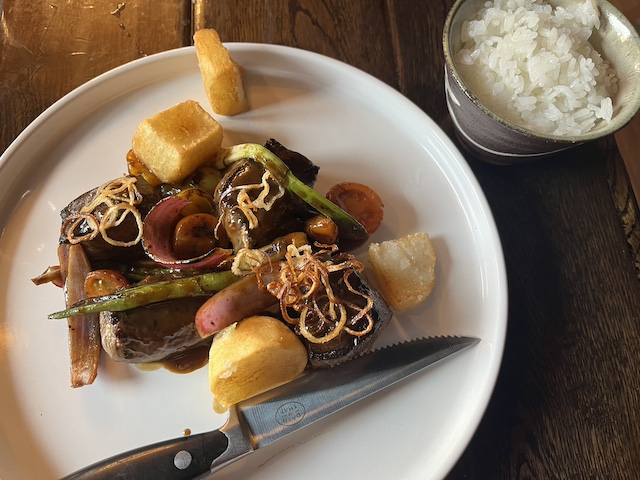How to grow fruit trees in Central Oregon
Published 12:00 am Tuesday, April 12, 2016

- Joe Kline / The Bulletin Landscape fabric works nicely to craft pockets for a pallet garden.
Amy Jo Detweiler, associate professor of horticulture at Oregon State University’s Extension Service, wants Central Oregon gardeners to be successful in growing fruit trees and managing an apple tree enemy, the codling moth.
She recently answered a few questions to help.
Q: Are fruit trees a challenge to grow here in Central Oregon?
A: The trees themselves actually grow pretty well here. The trick is, can you get fruit to set? Usually people don’t have problems getting them established; it’s just about whether or not you can get them to fruit successfully. So it depends on how you want to look at it.
Q: What kinds of fruit trees are we talking about here?
A: Apple trees are going to be the most reliable, as far as getting fruit to set, followed by Asian pears, plums, European pears, sour cherries. And then you get into your peaches and your sweet cherries.
Q: Do peaches do well here? What about other stone fruit?
A: You can get bumper crops of peaches, depending on our spring temps. Nectarine and apricot fruit earlier than peach, so they tend to get zapped. Usually the flowers don’t survive a spring here, so you won’t see as much fruit set on those ones.
Q: Are there specific varieties we should be looking for?
A: You do want to buy ones that are more cold tolerant for our region. Generally, you’re looking for those that are late blooming, rather than early blooming.
Q: Is it the late freeze claiming the blossoms that prevents trees from fruiting well?
A: It’s also related to cold injury in the bud stage. So it’s not necessarily related to when the flowers are out. For example, when we have a warming trend like we had this past month, you start to see the buds swell, and plants will start to come out of dormancy. As they come out of dormancy, their ability to withstand cold temperatures goes down, so they’re not as cold-hardy. Any injury in the bud or flowering stage could potentially be harmful.
Q: Are there any hints or tricks you’ve heard of for protecting from the cold?
A: Some people tell me they’ve used mini Christmas tree lights to wrap around the branches near the blossoms. Just that little bit of heat emitted near the blossom seems to help protect from cold temps with success.
Q: What are some considerations for where to plant fruit trees, soil amenities that may be helpful and general guidelines for care?
A: You want to select a site that gets full sun for any fruit tree. Ideally, six to eight hours of sunlight — that’ll maximize your fruit set. And you’ll need protection from deer. As far as soil considerations, most fruit trees will do OK in our pH here. But you’ll want to amend the planting area before you plant it. You’ll want one-third soil amendment and two-thirds native soil, mixing it together, then putting it back in. As a soil amendment, a well-aged compost is what’s going to work best for people. It increases the water-holding capacity of the native soil and really helps with root establishment. The first few years of growing fruit trees, you really just want to focus on getting those roots established and not worry so much about production. Make sure that you’re watering really well and fertilizing to keep new growth really healthy so they’re less vulnerable to insects and disease.
Q: How many years after planting should we expect to see some fruit, and how does pruning or thinning affect fruit production?
A: It depends on the tree species, but most will start fruit production within four to seven years. Then, depending on the tree, pruning becomes a really critical aspect of food production. Apple trees fruit on 1-year-old wood, and same with pear. Some stone fruits are going to set onto the current season’s growth, so you want to be thinking about timing your pruning just right. I would tell people to wait until the end of the winter, February going into March maybe. Then it’s about thinning the fruit.
Apples, for instance, usually come out in clusters of five blossoms, with one big flower and then four or so around it. You want to thin those flowers out to one or two. You’ll end up with a higher quality fruit, a larger fruit, and you’ll even out production from year to year. If you allow all of the fruit to set in a given year, the following year, your production will drop.
Q: I hear that OSU Extension Service is getting ready to kick off a new educational program for fruit tree growers in our region called Project Happy Apples. Can you tell me what the project is about and why it’s important?
A: Project Happy Apples addresses the problem of what homeowners call “wormy apples or pears,” which is related to the pests that cause that — the codling moth. I want this project to be a community effort, where people are taking care of the fruit trees in their own backyard. We’re not going to completely eradicate the problem, because once a pest population is established, it’s pretty hard to get rid of. But hopefully we can minimize the problem and teach people ways to protect their apple and pear trees against infestation.
Q: How widespread are problems related to these moths and the larva they produce?
A: There are very, very, very few apple trees that don’t have any codling moth. On a national level, this is a huge detrimental pest, because it could potentially take out the entire fruit tree industry. Even though we don’t have the type of production that, say, Hood River has, we still have a responsibility to try and minimize the pest population here.
Q: What does the life cycle of a codling moth look like, and what are some ways homeowners can manage against infestation?
A: The moth comes out in flight for about 21 days following full blossom and lays her eggs in the blossom end of the fruit that’s just starting to develop. The larvae hatch and begin to tunnel into the fruit and feed for a while, eventually coming out, but they leave their holes behind, sometimes creating mold from their excrement. So you count out 21 days, and that’s when you want to start managing for it. And typically, there will be two, sometimes three generations per summer, so it’s an ongoing problem.
Q: How will homeowners know when and what to use?
A: Most people won’t want to be looking up phenology calendars and keeping track of when these moths are in flight. And that’s what Project Happy Apples is all about: us doing the homework for you and then sending you an email blast that says, ‘Hey, this week, we should be putting out our codling moth traps,’ ‘This is when and how to bag your fruit to protect it’ or ‘This is how and when you could apply a biological control,’ so you can make an informed decision about how to manage for it. Another goal of the project is to reduce pesticide use, so people aren’t just grabbing anything off the shelf and spraying something that may not even protect against codling moth or may not be safe for the environment, bees or other pollinators.
Q: What are some of the specific solutions the project will recommend?
A: First, there’s monitoring devices, such as traps, which can be purchased at farm and garden supply stores. They use an activated pheromone that is species specific to attract the adult moths. They’ll get stuck on the trap, which helps homeowners count them, and indicates when to begin using another method. One of the more popular examples of a biological control method is actually a virus that you would spray, which is interesting. It’s called CYD-X and is very host-specific — so it only affects codling moth, not other beneficials in the environment — and it gets into the moth and affects the larva stage so they don’t survive.
A physical barrier method is to bag the fruit so they can’t get in to lay their eggs. You could use paper bags, or I’ve been testing out those silk organza bags with drawstrings that they sell at craft stores. An example of cultural control would be to pick up any fallen apples after the season, so they don’t give codling moths an overwintering site. Placing cardboard around the trunk of a tree is both a cultural control and physical barrier. They’ll come down the trunk to overwinter and they’ll stop and pupate in the cardboard. Then you can just replace the cardboard and throw it away. Pesticides or insecticides are an example of a chemical control method. But remember that even if you use an organic chemical control method, it can still be toxic and affect native pollinators such as honey and mason bees. Timing of application is essential, and that’s one of the things the program will be helping with.
Q: When does the program start, and how can people get involved?
A: People will want to go to our website and click on Project Happy Apples, then enter their email addresses. In late April, I’ll begin sending out the email blasts, reminders and suggestions. Maybe six per season. We’ve done the homework, and it’s research-based, and it will help fruit tree growers in Central Oregon make informed decisions about how to manage for these pests.
Q: Where can we find tree suppliers and answers to our other fruit tree-specific questions?
A: All of the specific information we offer about fruit tree selection, growth, pruning, harvest times and pollination can be found on our website: extension.oregonstate.edu/deschutes.
— Reporter: laurakessinger@gmail.com






